Module 11 Unit 3-2022-2023学年七年级英语下册同步精品课堂(外研版)(43张PPT)
文档属性
| 名称 | Module 11 Unit 3-2022-2023学年七年级英语下册同步精品课堂(外研版)(43张PPT) | 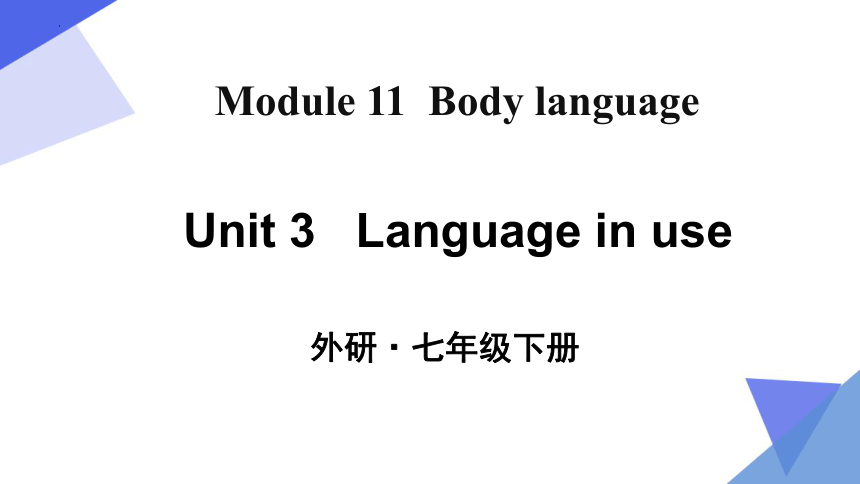 | |
| 格式 | pptx | ||
| 文件大小 | 2.2MB | ||
| 资源类型 | 教案 | ||
| 版本资源 | 外研版 | ||
| 科目 | 英语 | ||
| 更新时间 | 2023-05-07 20:53:55 | ||
图片预览

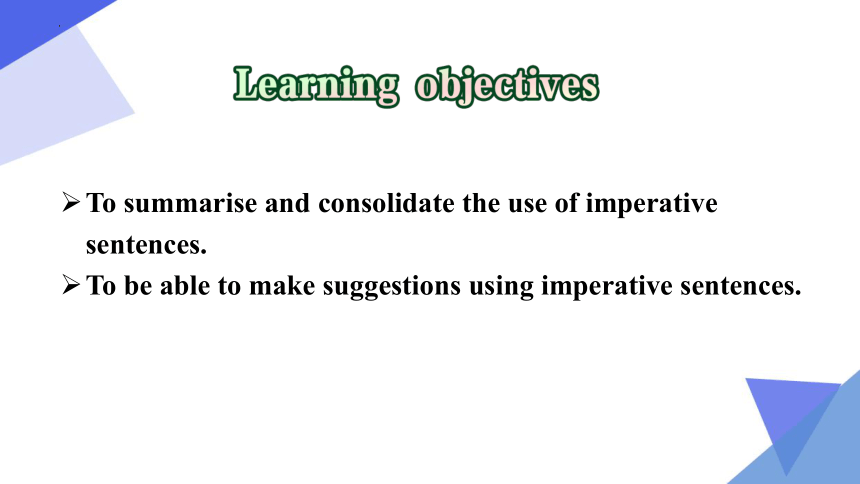

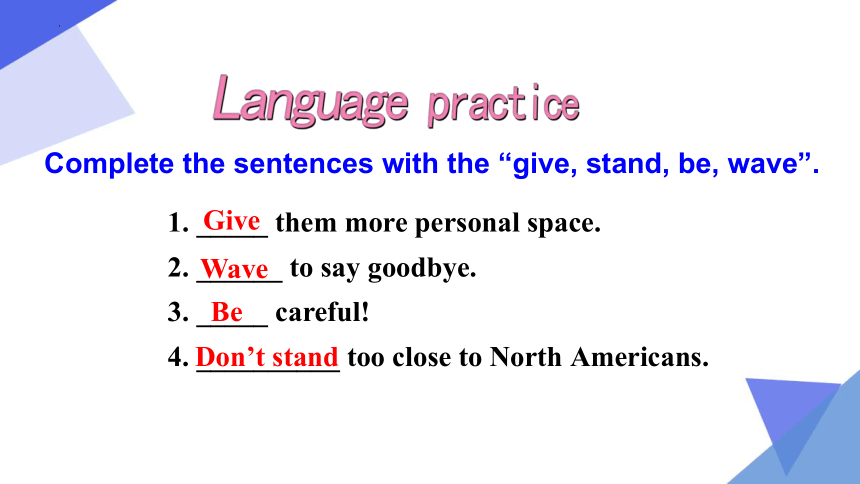
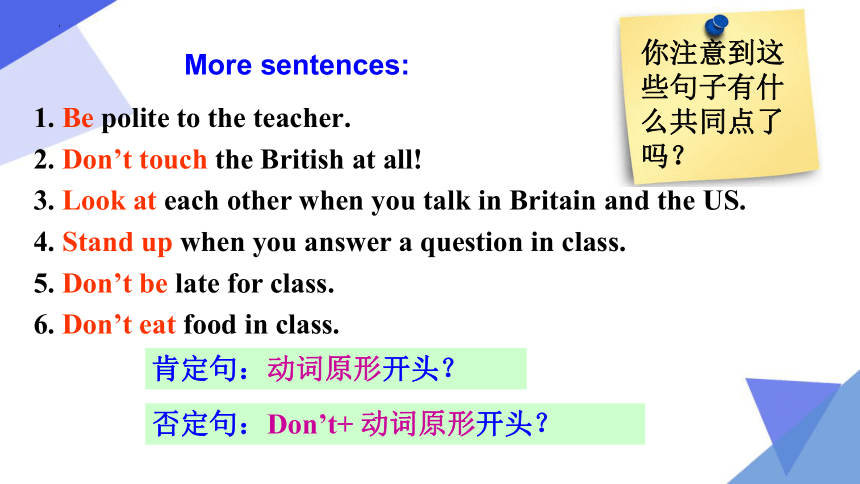

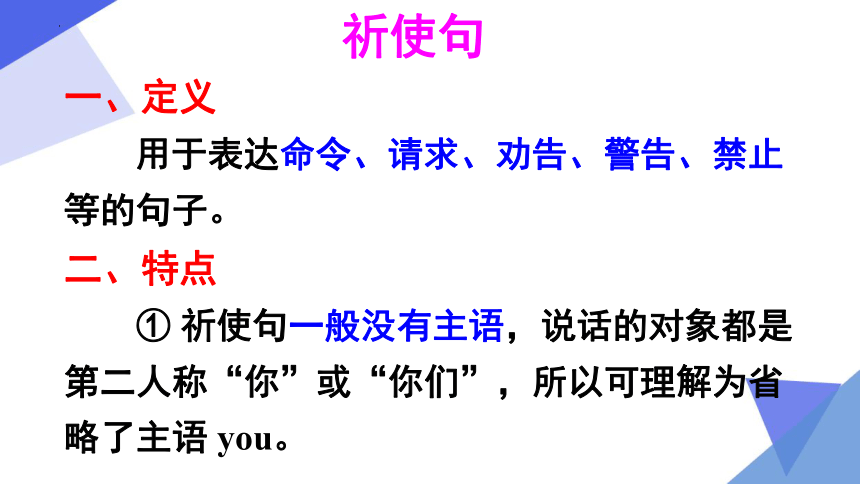
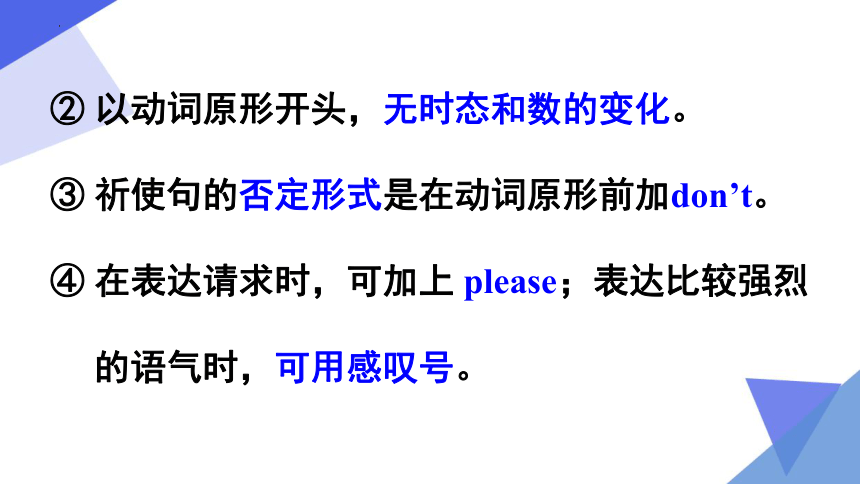
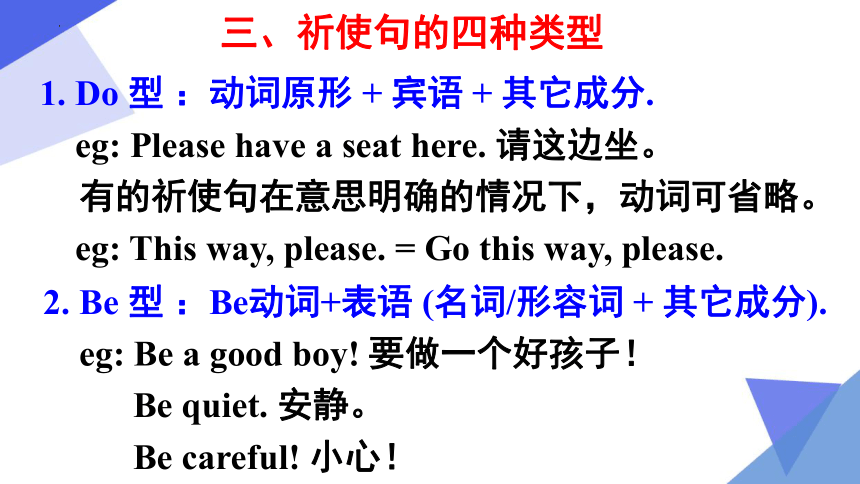
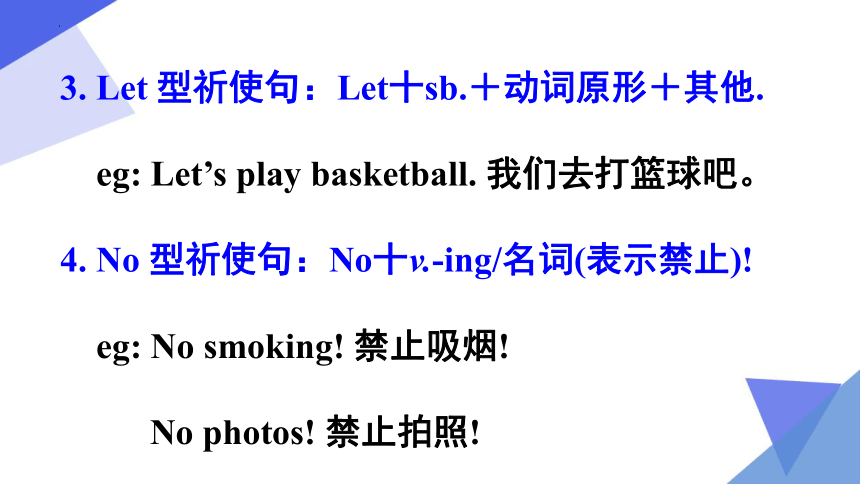
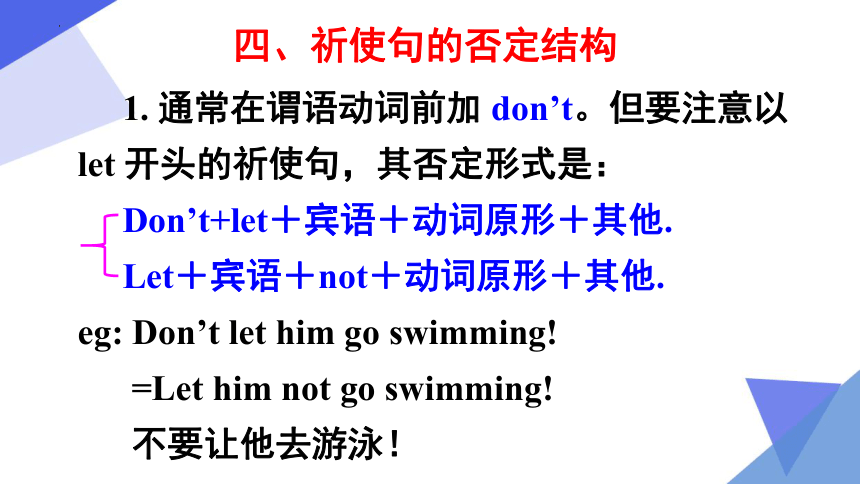
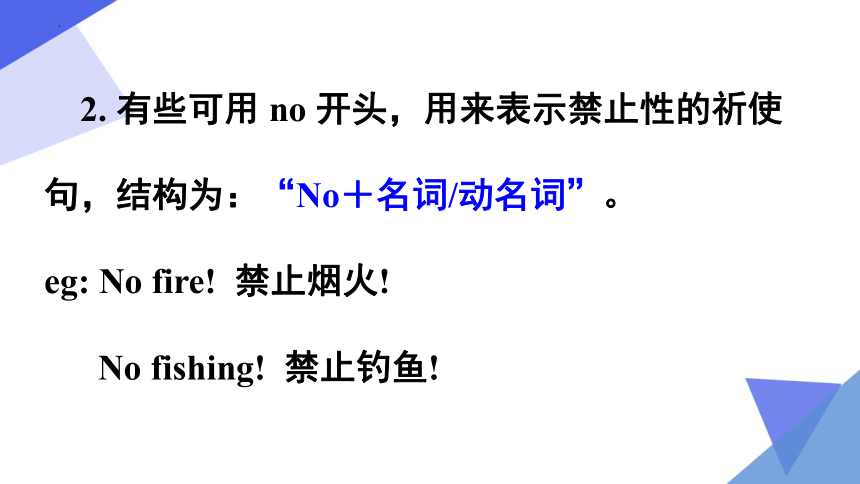
文档简介
(共43张PPT)
外研·七年级下册
Unit 3 Language in use
Module 11 Body language
To summarise and consolidate the use of imperative sentences.
To be able to make suggestions using imperative sentences.
She brought (bring的过去式) me some candy.
v. bring 带来
1. _____ them more personal space.
2. ______ to say goodbye.
3. _____ careful!
4. __________ too close to North Americans.
Be
Give
Don’t stand
Wave
Complete the sentences with the “give, stand, be, wave”.
1. Be polite to the teacher.
2. Don’t touch the British at all!
3. Look at each other when you talk in Britain and the US.
4. Stand up when you answer a question in class.
5. Don’t be late for class.
6. Don’t eat food in class.
More sentences:
你注意到这些句子有什么共同点了吗?
肯定句:动词原形开头?
否定句:Don’t+ 动词原形开头?
祈使句
祈使句
一、定义
用于表达命令、请求、劝告、警告、禁止等的句子。
二、特点
① 祈使句一般没有主语,说话的对象都是第二人称“你”或“你们”,所以可理解为省略了主语 you。
② 以动词原形开头,无时态和数的变化。
③ 祈使句的否定形式是在动词原形前加don’t。
④ 在表达请求时,可加上 please;表达比较强烈
的语气时,可用感叹号。
1. Do 型 :动词原形 + 宾语 + 其它成分.
eg: Please have a seat here. 请这边坐。
有的祈使句在意思明确的情况下,动词可省略。
eg: This way, please. = Go this way, please.
2. Be 型 :Be动词+表语 (名词/形容词 + 其它成分).
eg: Be a good boy! 要做一个好孩子!
Be quiet. 安静。
Be careful! 小心!
三、祈使句的四种类型
3. Let 型祈使句:Let十sb.+动词原形+其他.
eg: Let’s play basketball. 我们去打篮球吧。
4. No 型祈使句:No十v.-ing/名词(表示禁止)!
eg: No smoking! 禁止吸烟!
No photos! 禁止拍照!
1. 通常在谓语动词前加 don’t。但要注意以let 开头的祈使句,其否定形式是:
Don’t+let+宾语+动词原形+其他.
Let+宾语+not+动词原形+其他.
eg: Don’t let him go swimming!
=Let him not go swimming!
不要让他去游泳!
四、祈使句的否定结构
2. 有些可用 no 开头,用来表示禁止性的祈使句,结构为:“No+名词/动名词”。
eg: No fire! 禁止烟火!
No fishing! 禁止钓鱼!
五、加强语气的祈使句
在肯定祈使句中,我们可以用助动词 do 来加强语气。
eg: Do come, please! 请一定要来!
Do be quiet, please! 请务必安静!
1. 有时为了指明向谁提出请求或命令,可以加称呼语。
e.g. Tony, please sit down.
2. 祈使句在口语中还可以用到以下几种形式:
e.g. Help!
No photos/parking!
Hands up!
1) –Knock on the door before you go in!
– I will.
—进去之前要敲门!
—是的,我会的。
2) – Don’t forget to turn off the lights when you leave.
– I won’t.
— 离开时别忘记关灯。
— 不会忘记的。
祈使句表示要求、建议对方“将来”做或不做某事,因此其肯定应答语通常用I/we will。否定答语通常用 I/we won’t。
祈使句的应答语
口诀
下面的口诀总结了祈使句的一般规律。一起来看看吧!
祈使句,有特点,
动词原形摆在前,
否定句式也不难,
Don’t放在最前面,
其他一律都不变。
Do’s Don’ts
Britain Stand in line. Shake hands. Say “please” and “thank you”. Open doors for others. Look at people when you talk. Be on time. Touch people.
Ask a woman’s age.
Stand too close.
Say anything too personal.
1. Work in pairs. Talk about do's and don'ts in a foreign country.
Can I shake hands with people in Britain
Yes, you can.
Can I touch people in Britain
No, you can’t.
Stand in line.
Don’t touch people when you talk to them.
2. Make a list of do's and don'ts to help visitors to Britain.
Do shake hands when you meet a friend.
Do stand in line
Do expect rain.
Please talk about the weather.
Do say “please” and “thank you”.
Do look at people when you talk.
Don’t touch people.
Don’t ask people personal questions.
Don’t be late.
Don’t ask a woman’s age.
Don’t talk with food in your mouth.
It’s important to listen to the teacher.
Listen to the teacher.
Don’t shout in the classroom.
You cannot shout in the classroom.
For example:
3. Rewrite the sentences.
1. It’s important to be careful.
Be careful.
2. It’s important to clean and tidy the lab.
Clean and tidy the lab.
3. You cannot touch anything if the teacher doesn’t ask you to.
Don’t touch anything if the teacher doesn’t ask you to.
4. You cannot bring food or drink into the lab.
Don’t bring food or drink into the lab.
5. You cannot enter the lab alone.
Don’t enter the lab alone.
1) How do the British say hello to each other when they first meet
They shake hands with each other.
2) Does body language mean the same thing in different countries
No, it doesn’t.
all right arm in arm close different hold on to kiss three times point at shake hands with wave
4. Answer the questions. Use the words and expressions from the box to help you.
3) How do the Russians say hello to each other when they meet
They usually kiss three times.
4) Is it polite to stand close to North Americans
No, it isn’t.
5) Is it all right to wave goodbye in Greece
No, it isn’t.
6) How do you usually say goodbye with body language
I wave my hand.
all right arm in arm close different hold on to kiss three times point at shake hands with wave
The Japanese bow
In Japan, people bow to say “thank you”, “sorry”, “ hello”, “goodbye”, “you’re welcome”, “excuse me” and many other things. Children and young people
bow lower when they greet
older people. It’s a way of
being polite and showing respect.
Read the passage and choose the correct answers.
1. How do people in Japan say “thank you”, “sorry”, “hello”, “goodbye”, “you’re welcome”, “excuse me” and many other things
A. They bow. B. They nod.
2. Who bows lower when a young man meet an old man in Japan
A. The old man. B. The young man.
3. Is bowing the only way of being polite and showing respect in Japan
A. Yes, it is. B. No, it isn’t.
Making a poster
about body language
Work in pairs. Talk about different ways of saying hello and body language in China.
Step 1
In China, people greet with each other with head nodding, smile, hand shaking, hug and so on. People never kiss. Sometimes friends hug each other after long time separation. People wave to say goodbye.
Write the information on your poster.
Step 2
Find or draw some pictures to add to your poster.
Step 3
Show your poster to the whole class.
Step 4
In China, people greet each other with head nodding, smiling, hand shaking and so on. Sometimes friends hug each other after long time separation. People wave to say goodbye.
Language points
1. Be on time. 要准时。
例:我们应当按时到那里。
We should get there on time.
on time 意为“准时,按时”。指按规定的时间做某事。
【拓展】in time 意为“及时”,指正赶上时间或恰好在需要的时候。
例:当我饿了的时候,我妈码及时给我送来
了面包。
When I was hungry, my mother sent the
bread to me in time.
2. You cannot bring food or drink into the lab.
bring 及物动词,意为“带来”。其过去式为 brought。
bring sb. sth. (=bring sth. for sb.) 意为“给
某人带来某物”。
bring sb./sth. ( with sb.) 意为“随身带
上……” 。
辨析:bring 与 take
bring
带来;拿来
强调将某人或某物从别的地方带到说话的地方来
take
带走;拿走
强调从说话地将某人或某物带到别的地方去
3. Children and young people bow lower when
they greet older people.
low 此处用作副词,意为“低,向下”,lower是其比较级,意为“更低”。
例:她把帽子拉低,盖住了眼睛。
She pulled her hat low down over her eyes.
【拓展】low 用作形容词,意为“低的”,常用于修饰山、房屋等,反义词是 high。tall(反义词为 short)一般指人、动物、树木等有生命的东西,有时也用来指建筑物。
例:我们的村庄坐落于低矮的小山之间。
Our village lies among low hills.
4. It’s a way of being polite and showing respect.
show 此处用作及物动词,意为“表示;表现出”。show 还可表示“展示;给……看;带领”。show sth. to sb. 或 show sb. sth. 意为
“将某物展示给某人看”。
例:请尊敬你的父母。
Please show respect for your parents.
例:请把你的新电脑给我看看。
Please show your new computer to me.
=Please show me your new computer.
【拓展】show 还可用作名词,意为“演出,节目”。
例:你喜欢访谈节目吗
Do you like talk show
一、用括号内所给动词的适当形式填空。
1. It’s an important meeting. _________ (not,
be) late.
2. _____ ______ (not, make) any noise!
Your mother is sleeping.
3. ______ ______ (not, speak) with your mouth
full of food and ______ (be) polite.
Don’t be
Don’t make
Don’t speak
be
Exercise
4. ____ (give) us ten years and just see what our country will be like.
5. ________ (not, let) the baby cry.
6. Wear more clothes or you _________ (catch) a
cold.
7. No _________. (park)
Give
Don’t let
will catch
parking
祈使句用来表达请求、命令、劝告、希望、叮嘱等。
☆主语通常为第二人称you,且常省略,谓语动词一律用动词原形。
☆一般没有时态和语态的变化。
☆肯定式:动词原形+其他成分
(通常句首或句末加please)。
否定式:在谓语动词前面加 Don’t。
Homework
1. Make a list of do’s and don’ts in some other foreign countries.
2. Preview the new words and expressions in Module 12.
外研·七年级下册
Unit 3 Language in use
Module 11 Body language
To summarise and consolidate the use of imperative sentences.
To be able to make suggestions using imperative sentences.
She brought (bring的过去式) me some candy.
v. bring 带来
1. _____ them more personal space.
2. ______ to say goodbye.
3. _____ careful!
4. __________ too close to North Americans.
Be
Give
Don’t stand
Wave
Complete the sentences with the “give, stand, be, wave”.
1. Be polite to the teacher.
2. Don’t touch the British at all!
3. Look at each other when you talk in Britain and the US.
4. Stand up when you answer a question in class.
5. Don’t be late for class.
6. Don’t eat food in class.
More sentences:
你注意到这些句子有什么共同点了吗?
肯定句:动词原形开头?
否定句:Don’t+ 动词原形开头?
祈使句
祈使句
一、定义
用于表达命令、请求、劝告、警告、禁止等的句子。
二、特点
① 祈使句一般没有主语,说话的对象都是第二人称“你”或“你们”,所以可理解为省略了主语 you。
② 以动词原形开头,无时态和数的变化。
③ 祈使句的否定形式是在动词原形前加don’t。
④ 在表达请求时,可加上 please;表达比较强烈
的语气时,可用感叹号。
1. Do 型 :动词原形 + 宾语 + 其它成分.
eg: Please have a seat here. 请这边坐。
有的祈使句在意思明确的情况下,动词可省略。
eg: This way, please. = Go this way, please.
2. Be 型 :Be动词+表语 (名词/形容词 + 其它成分).
eg: Be a good boy! 要做一个好孩子!
Be quiet. 安静。
Be careful! 小心!
三、祈使句的四种类型
3. Let 型祈使句:Let十sb.+动词原形+其他.
eg: Let’s play basketball. 我们去打篮球吧。
4. No 型祈使句:No十v.-ing/名词(表示禁止)!
eg: No smoking! 禁止吸烟!
No photos! 禁止拍照!
1. 通常在谓语动词前加 don’t。但要注意以let 开头的祈使句,其否定形式是:
Don’t+let+宾语+动词原形+其他.
Let+宾语+not+动词原形+其他.
eg: Don’t let him go swimming!
=Let him not go swimming!
不要让他去游泳!
四、祈使句的否定结构
2. 有些可用 no 开头,用来表示禁止性的祈使句,结构为:“No+名词/动名词”。
eg: No fire! 禁止烟火!
No fishing! 禁止钓鱼!
五、加强语气的祈使句
在肯定祈使句中,我们可以用助动词 do 来加强语气。
eg: Do come, please! 请一定要来!
Do be quiet, please! 请务必安静!
1. 有时为了指明向谁提出请求或命令,可以加称呼语。
e.g. Tony, please sit down.
2. 祈使句在口语中还可以用到以下几种形式:
e.g. Help!
No photos/parking!
Hands up!
1) –Knock on the door before you go in!
– I will.
—进去之前要敲门!
—是的,我会的。
2) – Don’t forget to turn off the lights when you leave.
– I won’t.
— 离开时别忘记关灯。
— 不会忘记的。
祈使句表示要求、建议对方“将来”做或不做某事,因此其肯定应答语通常用I/we will。否定答语通常用 I/we won’t。
祈使句的应答语
口诀
下面的口诀总结了祈使句的一般规律。一起来看看吧!
祈使句,有特点,
动词原形摆在前,
否定句式也不难,
Don’t放在最前面,
其他一律都不变。
Do’s Don’ts
Britain Stand in line. Shake hands. Say “please” and “thank you”. Open doors for others. Look at people when you talk. Be on time. Touch people.
Ask a woman’s age.
Stand too close.
Say anything too personal.
1. Work in pairs. Talk about do's and don'ts in a foreign country.
Can I shake hands with people in Britain
Yes, you can.
Can I touch people in Britain
No, you can’t.
Stand in line.
Don’t touch people when you talk to them.
2. Make a list of do's and don'ts to help visitors to Britain.
Do shake hands when you meet a friend.
Do stand in line
Do expect rain.
Please talk about the weather.
Do say “please” and “thank you”.
Do look at people when you talk.
Don’t touch people.
Don’t ask people personal questions.
Don’t be late.
Don’t ask a woman’s age.
Don’t talk with food in your mouth.
It’s important to listen to the teacher.
Listen to the teacher.
Don’t shout in the classroom.
You cannot shout in the classroom.
For example:
3. Rewrite the sentences.
1. It’s important to be careful.
Be careful.
2. It’s important to clean and tidy the lab.
Clean and tidy the lab.
3. You cannot touch anything if the teacher doesn’t ask you to.
Don’t touch anything if the teacher doesn’t ask you to.
4. You cannot bring food or drink into the lab.
Don’t bring food or drink into the lab.
5. You cannot enter the lab alone.
Don’t enter the lab alone.
1) How do the British say hello to each other when they first meet
They shake hands with each other.
2) Does body language mean the same thing in different countries
No, it doesn’t.
all right arm in arm close different hold on to kiss three times point at shake hands with wave
4. Answer the questions. Use the words and expressions from the box to help you.
3) How do the Russians say hello to each other when they meet
They usually kiss three times.
4) Is it polite to stand close to North Americans
No, it isn’t.
5) Is it all right to wave goodbye in Greece
No, it isn’t.
6) How do you usually say goodbye with body language
I wave my hand.
all right arm in arm close different hold on to kiss three times point at shake hands with wave
The Japanese bow
In Japan, people bow to say “thank you”, “sorry”, “ hello”, “goodbye”, “you’re welcome”, “excuse me” and many other things. Children and young people
bow lower when they greet
older people. It’s a way of
being polite and showing respect.
Read the passage and choose the correct answers.
1. How do people in Japan say “thank you”, “sorry”, “hello”, “goodbye”, “you’re welcome”, “excuse me” and many other things
A. They bow. B. They nod.
2. Who bows lower when a young man meet an old man in Japan
A. The old man. B. The young man.
3. Is bowing the only way of being polite and showing respect in Japan
A. Yes, it is. B. No, it isn’t.
Making a poster
about body language
Work in pairs. Talk about different ways of saying hello and body language in China.
Step 1
In China, people greet with each other with head nodding, smile, hand shaking, hug and so on. People never kiss. Sometimes friends hug each other after long time separation. People wave to say goodbye.
Write the information on your poster.
Step 2
Find or draw some pictures to add to your poster.
Step 3
Show your poster to the whole class.
Step 4
In China, people greet each other with head nodding, smiling, hand shaking and so on. Sometimes friends hug each other after long time separation. People wave to say goodbye.
Language points
1. Be on time. 要准时。
例:我们应当按时到那里。
We should get there on time.
on time 意为“准时,按时”。指按规定的时间做某事。
【拓展】in time 意为“及时”,指正赶上时间或恰好在需要的时候。
例:当我饿了的时候,我妈码及时给我送来
了面包。
When I was hungry, my mother sent the
bread to me in time.
2. You cannot bring food or drink into the lab.
bring 及物动词,意为“带来”。其过去式为 brought。
bring sb. sth. (=bring sth. for sb.) 意为“给
某人带来某物”。
bring sb./sth. ( with sb.) 意为“随身带
上……” 。
辨析:bring 与 take
bring
带来;拿来
强调将某人或某物从别的地方带到说话的地方来
take
带走;拿走
强调从说话地将某人或某物带到别的地方去
3. Children and young people bow lower when
they greet older people.
low 此处用作副词,意为“低,向下”,lower是其比较级,意为“更低”。
例:她把帽子拉低,盖住了眼睛。
She pulled her hat low down over her eyes.
【拓展】low 用作形容词,意为“低的”,常用于修饰山、房屋等,反义词是 high。tall(反义词为 short)一般指人、动物、树木等有生命的东西,有时也用来指建筑物。
例:我们的村庄坐落于低矮的小山之间。
Our village lies among low hills.
4. It’s a way of being polite and showing respect.
show 此处用作及物动词,意为“表示;表现出”。show 还可表示“展示;给……看;带领”。show sth. to sb. 或 show sb. sth. 意为
“将某物展示给某人看”。
例:请尊敬你的父母。
Please show respect for your parents.
例:请把你的新电脑给我看看。
Please show your new computer to me.
=Please show me your new computer.
【拓展】show 还可用作名词,意为“演出,节目”。
例:你喜欢访谈节目吗
Do you like talk show
一、用括号内所给动词的适当形式填空。
1. It’s an important meeting. _________ (not,
be) late.
2. _____ ______ (not, make) any noise!
Your mother is sleeping.
3. ______ ______ (not, speak) with your mouth
full of food and ______ (be) polite.
Don’t be
Don’t make
Don’t speak
be
Exercise
4. ____ (give) us ten years and just see what our country will be like.
5. ________ (not, let) the baby cry.
6. Wear more clothes or you _________ (catch) a
cold.
7. No _________. (park)
Give
Don’t let
will catch
parking
祈使句用来表达请求、命令、劝告、希望、叮嘱等。
☆主语通常为第二人称you,且常省略,谓语动词一律用动词原形。
☆一般没有时态和语态的变化。
☆肯定式:动词原形+其他成分
(通常句首或句末加please)。
否定式:在谓语动词前面加 Don’t。
Homework
1. Make a list of do’s and don’ts in some other foreign countries.
2. Preview the new words and expressions in Module 12.
同课章节目录
- Module 1 Lost and found
- Unit 1 Whose bag is this?
- Unit 2 Are they yours?
- Unit 3 Language in use
- Module 2 What can you do ?
- Unit 1 I can play the piano
- Unit 2 I can run really fast
- Unit 3 Language in use
- Module 3 Making plans
- Unit 1 What are you going to do at the weekends?
- Unit 2 We're going to cheer the players.
- Unit 3 Language in use
- Module 4 Life in the future
- Unit 1 Everyone will study at home
- Unit 2 Every family will have a small plane.
- Unit 3 Language in use
- Module 5 Shopping
- Unit 1 What can I do for you?
- Unit 2 You can buy everything on the Internet
- Unit 3 Language in use
- Module 6 Around town
- Unit 1 Could you tell me how to get to the Nationa
- Unit 2 The London Eye is on your right.
- Unit 3 Language in use
- Revision module A
- Module 7 My past life
- Unit 1 I was born in a small village.
- Unit 2 I was born in Quincy.
- Unit 3 Language in use
- Module 8 Story time
- Unit 1 Once upon a time….
- Unit 2 Goldilocks hurried out of the house.
- Unit 3 Language in use
- Module 9 Life history
- Unit 1 He left school and began work at the age of
- Unit 2 He decided to be an actor.
- Unit 3 Language in use
- Module 10 A holiday journey
- Unit 1 What did you do?
- Unit 2 This morning we took a walk.
- Unit 3 Language in use
- Module 11 Body language
- Unit 1 They touch noses!
- Unit 2 Here are some ways to welcome them.
- Unit 3 Language in use
- Module 12 Western music
- Unit 1 It's so beautiful!
- Unit 2 Vienna is the centre of European classical
- Unit 3 Language in use
- Revision module B
